| 1 | Mud snake |
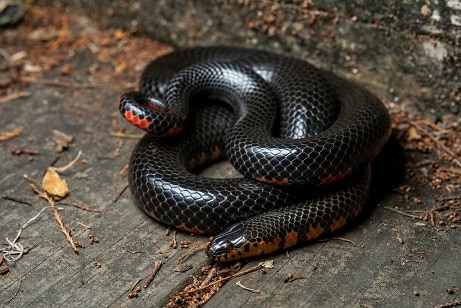
Venomous? No.
A black and red snake of backcountry swamps, where they often coexist with hungry alligators. Mud snakes are peaceful, and you can easily pick them up in your arms without being bitten. This is a large snake, regularly reaching 1.2 metres, with a thick body to match. They’re hard to miss, as their main scales are a midnight black, contrasting sharply against a bright red belly. Some of the red scales extend to the head as well.
Mud snakes rarely enter human habitation, except those adjacent to swamps. They’re a snake of rural Florida, most often spotted crossing backcountry roads. They usually stick to their swamps closely, but in heavy downpours, they become more adventurous and can travel hundreds of metres from their watery bases.
Mud snakes have a strange habit of biting their tail and curling up into a circle when spooked, floating lifelessly on the water. This inspired a classic legend: that mud snakes are a “hoop snake” which roll towards innocent people at high speeds.
| 2 | Eastern diamondback rattlesnake |
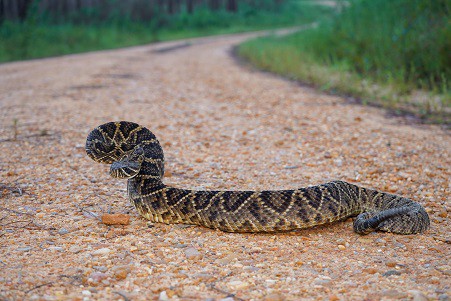
Venomous? Yes.
The eastern diamondback isn’t just the largest venomous snake in Florida, it’s the largest, bulkiest rattlesnake of the 32-strong family. This killer is particularly common on forest game trails, or paths through remote grassy fields. It inhabits the entire state except the Florida keys, but is becoming increasingly rare due to habitat destruction. Thankfully, this snake never invades people’s bedrooms at the dead of night – it sticks to isolated countryside areas.
Eastern diamondback rattlesnake venom has an LD50 score of 1.2mg, defeating the copperhead at 10.9mg. The venom is yellow coloured, and if you’re bitten while walking your dog, you’ll mostly experience severe skin necrosis and haemorrhaging.
Eastern diamondbacks like to reside in burrows, despite being poor diggers. Its rattle can be heard from 9 metres away, and its average adult length is 1.7 metres. Every year, smiling Florida locals are pictured holding even larger ones – 2.5 metres, 3 metres, or even 4.5 metres. Some are artificially enlarged using a photography trick called forced perspective, but others are indeed unnaturally huge. The confirmed record for this Florida snake is 2.5 metres.
| 3 | Southern black racer |
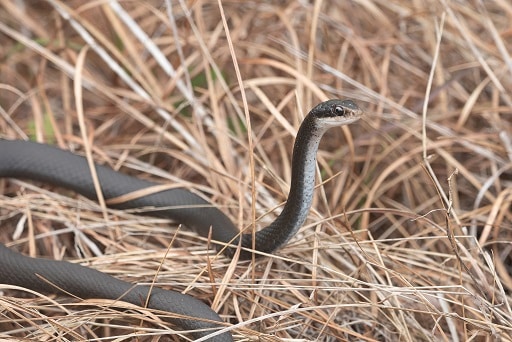
Venomous? No.
The most hyperactive of Florida’s snakes. This is a subspecies of the eastern racer (coluber constrictor), the signature subspecies of Florida, and occupies a large chunk of the state, including a few of the Florida keys. Black racers are black on almost all of their bodies, with their chins being paler. They’re non venomous, but despise being handled, and almost never calm down in captivity no matter how long you keep them.
Black racers are extremely energetic. They slither at 4mph, the speed of a human’s brisk walk, and they’re expert climbers, often zipping up trees when startled. Black racers have no specific habitat, and they’re the Florida snake most commonly spotted in suburban neighbourhoods. They couldn’t care less what they eat – mammals, reptiles, and amphibians are all possibilities, which they chase down at high speeds and then constrict.
The black racer also has excellent eyesight, and often raises its head up to scan the surroundings. Consequently, their favourite wild spots are open fields and grasslands, but they’re also found in trash piles and on roadsides.
| 4 | Eastern coral snake |
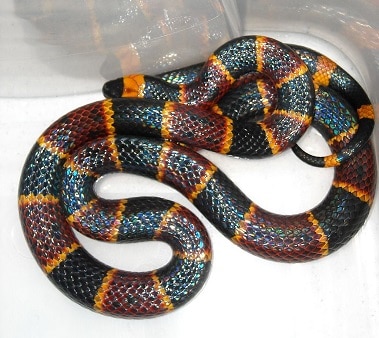
Venomous? Yes.
This colourful killer has only a small venom quantity per bite, at 3-5mg. Its fangs are small, and cannot penetrate human flesh deeply. But drop for drop, the eastern coral snake has the strongest venom of any Floridian snake. The LD50 score is 0.2mg, versus the eastern diamondback’s 1.2mg.
Eastern coral snakes are a citizen of wide, spacious forests, including high pine, scrub oak and broadleaf forests. Like most coral snakes, their natural instinct is to burrow, or take shelter in claustrophobic spots. Eastern coral snakes never charge around – they’re normally found below rotting logs, in leaf litter, or nestled in rock piles. This is a common Florida snake, but only one death has taken place over the last 60 years (in 2006), mainly because it’s so shy.
Nevertheless, picking up this snake while on a woodland jolly with your mates isn’t a smart idea. Another gruesome feature is eating other snakes for its diet. Two of its confirmed victims are on our list: the mud snake and eastern racer.
| 5 | Striped crayfish snake |
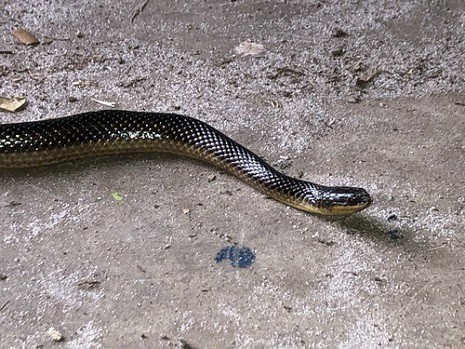
Venomous? No.
This Floridian snake is rarely seen by the average layman, but they’re secretly one of the most numerous. The striped crayfish snake numbers 1 million across Florida and Georgia. This is only a short snake, with a record of 70.5cm and a standard range of 30-55cm. But it has one special physical feature: dagger-like front fangs designed for breaking through hard crayfish shells. This snake is a crayfish specialist, with one prey being the slough crayfish.
Striped crayfish snakes mainly live in slow-moving rivers. They’re active by day, and spend those hours patrolling the riverbanks for crayfish burrows to invade. Their goal is to eat the inhabitants, and instead of constricting, their first contact is the brutal shell-penetrating bite, which they use to grip them.
If you’re lucky, you might spot this Florida snake on a comfy riverboat cruise. One of Florida’s worst invasive species is water hyacinth, a thick mat of green vegetation, which grows incredibly fast. If uncontrolled, this weed can fully cover rivers, and choke out native life beneath. But the striped crayfish snake is a rare species to benefit from hyacinth, as it’s an excellent shelter from predatory birds.
| 6 | Pygmy rattlesnake |
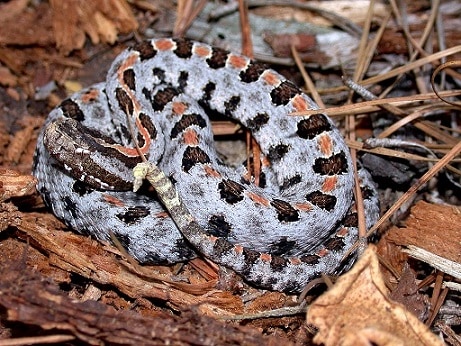
Venomous? Yes.
Florida has 3 rattlesnake species, with the timber rattlesnake restricted to a few northern counties. The eastern diamondback wins for deadliness, but the pygmy rattlesnake is the most common. This is the smallest rattlesnake species, measuring 40-60cm on average. Its fangs are a mere 0.5cm, even in adulthood, yet its venom can pack a powerful punch, delivering hemotoxins which totally disable blood clotting. There are no confirmed deaths on record, but in 2015, a 17 month old boy survived by the skin of his teeth.
You can encounter the pygmy rattlesnake in many locations – forests, fields, well-manicured golf courses. A great place to find them is rotting logs, which they wait next to in ambush, hoping for scurrying mammals to run along the top so they can snatch them up.
Pygmy rattlesnakes have the claim to fame of eating poisonous centipedes, including the fearsome giant desert centipede. Florida is specifically home to the dusky pygmy rattlesnake, a darker subspecies with red tinges and more rounded patterns. The largest dusky on record reached 63.8cm, a snake from St Petersburg, Florida.
| 7 | Florida cottonmouth |
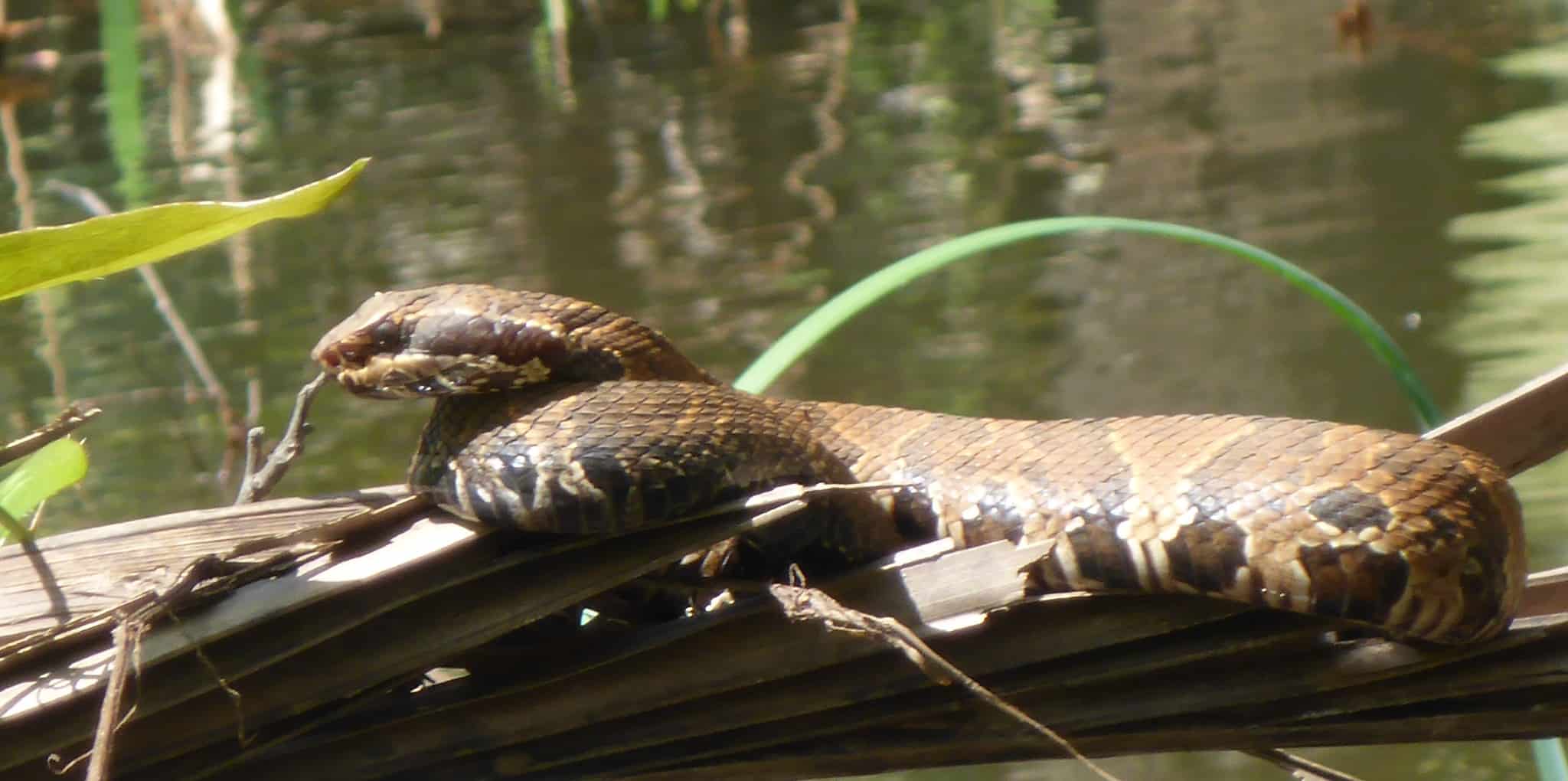
Venomous? Yes.
Originally a subspecies of the main cottonmouth (Agkistrodon piscivorus), but separated into its own species in 2015, thanks to state of the art genetic analysis. It’s now called Agkistrodon conanti, and differs with lighter and cleaner facial patterns, plus a significantly longer tail than the northern cottonmouth.
Cottonmouths are mainly a water snake, ambling slowly around Florida lakes. They’re subject to many wacky rumours, including leaping from tree branches to land on unsuspecting fishing boats below. Rural Floridians will tell tales in bars of this snake pursuing them for miles and miles, but cottonmouths are actually relaxed. However, their venom is still extremely powerful. 17% of untreated bites can be fateful, and the venom causes extensive necrosis on the nearby limbs. Anyone bitten by this snake should seek immediate medical care.
Cottonmouths are a thick-bodied snake, and also appear in swamps, coexisting with the mud snake. They particularly like thickets along the edges of swamps, and it’s rare for them to leave their watery domains.
| 8 | Scarlet snake |
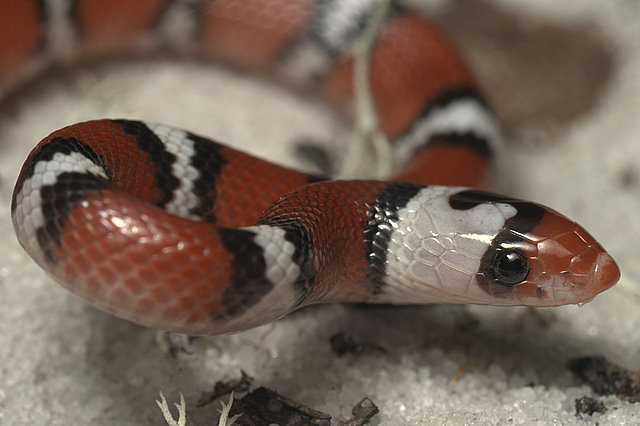
Venomous? No.
The scarlet snake mostly hangs out in spacious forests, such as dry prairies and flatwoods. Dry, loose soils are a must for the scarlet snake, as this is a burrowing species, using a rounded nose to carve out its own dens. This is an underground dweller, and when above ground they still lurk under woody debris and branches.
Consequently, the scarlet snake is one of Florida’s most elusive. They’re not rare, but tracking one down is an epic challenge, as they so rarely poke their heads out. This is the holy grail of some Florida reptile enthusiasts. If they do succeed, then there’s no certain death awaiting, as the scarlet snake is non-venomous. Their top prey is lizards, but scarlet snakes have a particular taste for turtle eggs. Their strategy is to invade a turtle den, wrap themselves around the egg, and squeeze hard until the golden yolk bursts free.
Despite their peaceful temperament, scarlet snakes have unusually sharp front fangs. Scarlet snakes can also be spotted on beaches in Florida occasionally.
| 9 | Ring-necked snake |
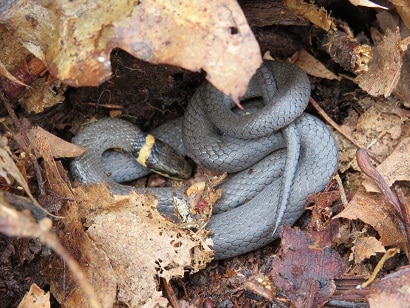
Venomous? Yes.
A small, humble snake which often congregates under shelter in vast numbers. If you dedicate yourself to exploring a forest and ripping up as much rotting wood as you can, it’s possible to find hundreds of ring-necked snakes within one hour. The ring-necked snake measures 30-45cm and is thin to boot. Despite being tiny, it does possesses venom, a weak-rear fanged venom which has no chance of killing a human.
Their signature white neck ring is the only notable pattern; most of their body is a dull olive. Ring-necked snakes (Diadophis punctatus) like to laze around eating insects, particularly ants, and they even live in anthills sometimes. Ring-necked snakes sometimes stray close to human dwellings, particularly gardens where sheet metal is piled up.
The versions in Florida are slightly different to normal. The main Florida subspecies is the southern ring-necked snake (d. p. punctatus), which often has an incomplete white ring. The keys ring-necked snake (d. p. acricus) is very rare, and is sometimes missing the ring entirely, or has a very faint one. The USA holds 14 ring-necked subspecies in total.
| 10 | Corn snake |
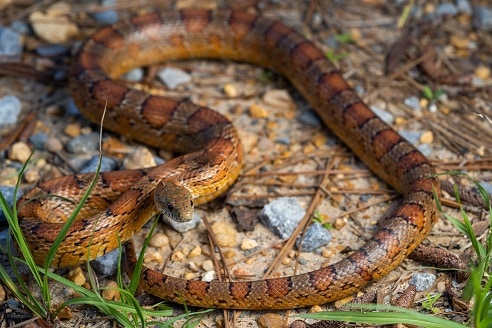
Venomous? No.
The corn snake is the world’s most popular captive snake, but the wild populations are carrying on as they have for millions of years. Its homeland is the southeastern USA, and that means that Florida is crawling with them. This is a peaceful constrictor, which commonly slithers into agricultural fields in order to feeds on the rats there. Corn snakes were named for helping out the crop farmers of old, as far back as the 1600s.
Corn snakes inhabit every county in Florida, including the southern keys. One of their top skills is climbing trees, including sheer vertical trunks. Corn snakes have flat bellies rather than round, and the scales are jagged, allowing them to dig in for purchase. They often climb trees to raid bird nests, and another common spot is on roads, where they like to bask on the warm tarmac.
In captivity, there are countless colourful morphs like candy cane and blue-striped, but the wild versions are red with orange blotches. However, Gainesville, Florida has a purely natural colour morph, called “blood red”, which lacks the orange patterns.